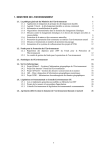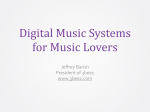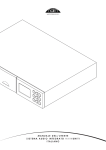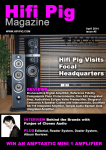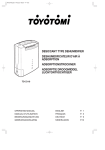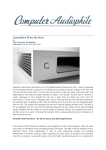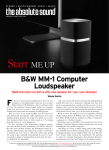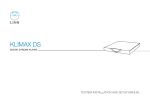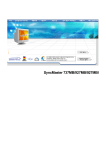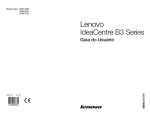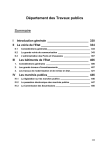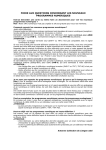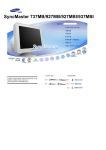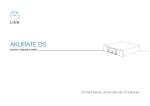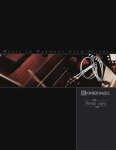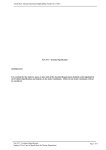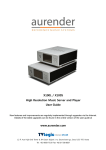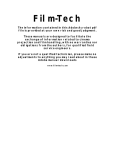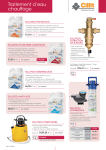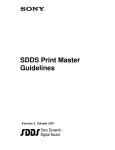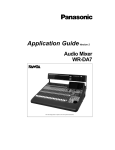Download TAS article
Transcript
Better than Hi-Res! Meridian’s Breakthrough MQA! JADIS DA88SMAGNIFIQUE! INTEGRATED AMP COMPUTER AUDIO PRIMER Everything You Need to Know AMAZING INTEGRATED AMP Rowland’s Continuum S2 KILLER-GOOD PSB’s $1295 Tower Speaker 3 GREAT EUROPEAN SPEAKERS Avantgarde, Kharma, and Estelon STATE OF THE ART Moon 430 Headphone Amp MUSIC FROM Neil Young, Tony Bennett, Duke Ellington, and more PLUS: The Best Hi-Res Downloads MAY/JUNE 2015 $6.99 US / $6.99 CAN DISPLAY UNTIL JUNE 20TH 2015 Contents 142 Cover Story: Jadis DA88S MkII Integrated Amplifier The iconic French marque has created a musical, technical, and visual masterpiece with this new integrated amp, says Jacob Heilbrunn. 50 Beyond High Resolution: Meridian Audio’s Master Quality Authenticated (MQA) Robert Harley brings you an in-depth look at a revolutionary new technology that not only delivers sound quality better than 192/24, but does so at a bit rate that can be streamed to your phone. Plus: MQA co-architect Bob Stuart reveals the inside story behind MQA in this candid interview. 34 Understanding Digital Music Systems Confused by all the new component categories—renderer, streamer, server, bridge? Dr. Jeffrey Barish tells you everything you need to know about the new digital architecture in this comprehensive primer. SENIOR WRITERS EDITOR-IN-CHIEF Robert Harley EXECUTIVE EDITOR Jonathan Valin Anthony H. Cordesman, Wayne Garcia, Jim Hannon, Robert E. Greene, Ted Libbey, Arthur Lintgen, Dick Olsher, Andrew Quint, Don Saltzman Paul Seydor, Steven Stone, Alan Taffel, Greg Weaver ACQUISITIONS MANAGER AND ASSOCIATE EDITOR Neil Gader MANAGING AND DIGITAL EDITOR Julie Mullins MUSIC EDITOR Jeff Wilson PROOFREADER Mark Lehman CREATIVE DIRECTOR Torquil Dewar ART DIRECTOR Shelley Lai PRODUCTION INTERN Rachel Holder theabsolutesound.com WEBMASTER Garrett Whitten 2 May/June 2015 the absolute sound VICE PRESIDENT/GROUP PUBLISHER Jim Hannon NEXTSCREEN CHAIRMAN AND CEO REVIEWERS AND CONTRIBUTING WRITERS Duck Baker, Soren Baker, Greg Cahill, Stephen Estep, Vade Forrester, Jacob Heilbrunn, Andre Jennings, Sherri Lehman, David McGee, Kirk Midtskog, Bill Milkowski, Derk Richardson, Karl Schuster Reprints: Nick Iademarco, Wright's Media, (877) 652-5295, (281) 4195725, [email protected]. Subscriptions, renewals, changes of address: 888-732-1625 and outside the U.S. 760-317-2327 or write The Absolute Sound, Subscription Services, PO Box 469042, Escondido, CA 92046. Ten issues: in the U.S., $29.90; Canada $45.90 GST included); outside North America, $64.90. Payments must be by credit card (VISA, MasterCard, American Express) or U.S. funds drawn on a U.S. bank, with checks payable to NextScreen, LLC. Address letters to the editor: The Absolute Sound, 8868 Research Blvd., Suite 108 Austin, TX 78758 or e-mail: [email protected] Newsstand Distribution and Local Dealers: Ingram Periodicals, 18 Ingram Blvd, LaVergne, TN 37086-7000 615 213-5223 Publishing matters: contact Jim Hannon at the address below or e-mail [email protected] Tom Martin ADVERTISING REPS Cheryl Smith (512) 891-7775 Marvin Lewis (718) 225-8803 (MTM Sales) Scott Constantine (609) 275-9594 Publications Mail Agreement 40600599 Return Undeliverable Canadian Addresses to: Station A / P.O. Box 54 / Windsor, ON N9A 6J5 NextScreen, LLC., 8868 Research Blvd., Suite 108 Austin, TX 78758. (512) 892-8682 fax: (512) 891-0375, [email protected], [email protected] ©2015 NextScreen, LLC., Issue 253 May/Jun 2015. The Absolute Sound (ISSN #0097-1138) is published 10 times per year in the months of Jan, Feb, Mar, April, combined issues in May/Jun & Jul/Aug, Sept, Oct, Nov, and Dec, $29.90 per year for U.S. residents, NextScreen, LLC., 8868 Research Blvd., Suite 108 Austin, TX 78758. Periodical Postage paid at Austin, Texas, and additional mailing offices. Canadian publication mail account #1551566 POSTMASTER: Send address changes to The Absolute Sound, Subscription Services PO Box 469042 Escondido, CA 92046. Printed in the USA Understanding Digital Music Systems Jeffrey Barish M any music lovers considering the leap to a digital music system find the new technology intimidating. Terminology is inconsistent; architectures for complete systems are amorphous; configuration options are bewildering; obsolescence is always a threat. Though procrastination might seem prudent, the potential benefits are enticing. Digital systems allow you to store a large music collection in a box no larger than a CD player. Cataloging software makes it easy to find recordings, and control software makes it possible to play them without leaving the comfort of your sofa. Storage capabilities also provide convenient safekeeping for music downloads. Support for HD audio promises a listening experience superior to that of CDs and LPs. The potential rewards are great, but the risk of an inauspicious purchase is real. This article attempts to lower anxiety by confronting the bugbears. I will present the architecture of a complete digital system and show how products from different categories map onto different subsets of this architecture. Using this mechanism, I will define a set of terms that unambiguously describes components in a digital music system. I will also respond to questions frequently asked by newcomers. After reading this article, I hope you will feel more confident as you embark on your quest for a modern audio system. The Terminology Problem it to a big signal at its output no matter which company manufactures the product. Manufacturers differentiate their power amplifiers by characteristics such as the class of the output stage (A, AB, B, or D), whether they use tubes or transistors, or the appearance of the casework, but users can always count on connecting a line-level signal to the input and loudspeakers to the output. Digital systems are more amorphous. The binary numbers that comprise the digital representation of an audio signal are robust. You can transfer them through cables, optical fiber, metal traces, or air. You can store them on hard-disk drives, DRAM, solid-state drives, or flash drives. You can subject them to electromagnetic interference, ground loops, or transmission-line effects. You can perform mathematical operations that make it possible to pack more of them in a given amount of storage. None of this matters as long as the numbers you started with are the ones that ultimately arrive at the destination. Numbers are numbers no matter what they represent, so digital systems are able to use elements to carry a variety of signals. The same internal buses that carry digital audio at one moment carry control signals or unrelated data at others. A USB interface can be used to communicate with a mouse, a keyboard, a monitor, a network interface, a hard-disk drive, a DAC, and much more. Analog systems do nothing comparable because the purpose of an analog interface is defined by the function of the device it is attached to, not by an abstract description encoded in numbers. Finally, the function of digital circuits is determined in large part by software, not just by the interconnection of electronic components. Software is easy to change because it too is composed of numbers. The same hardware can perform radically different functions simply by altering the software. For these reasons, digital systems are much more pliable than analog systems are. Much of the confusion surrounding digital music systems results from inconsistent terminology. Different manufacturers use different terms to describe components that do essentially the same thing. A device that plays a digital recording might be called a network player, a music player, a digital audio player, a media server, a music server, a streamer, or a media renderer. Part of the explanation for this hash of terminology is poor choices by the developers of related technical standards; part is the desire of manufacturers Sound sources to differentiate their products; and part is simply the Receiver haphazard way in which language evolves. The terminology for analog music systems does Record player Integrated amplifier not suffer from these problems. Use the words “amplifier,” “integrated amplifier,” “preamplifier,” “tuner,” “receiver,” or “loudspeaker” in the right Tuner Preamplifier Power amplifier company, and no one will misunderstand you. Moreover, most people in this group implicitly understand how those components map onto a block diagram of an analog music system (Fig. 1). CD Player Through long use, these terms are widely understood to refer to one thing. A power amplifier, for example, takes a small signal at its input and transforms Fig 1: Block diagram for a complete analog music system 34 May/June 2015 the absolute sound Speaker A Speaker B Understanding Digital Music Systems Internet HDD HDD (sound) (backup) from either an HDD connected directly to the computer (“direct”) or from the network (“network”). In some cases, products are able to retrieve sound data from either source; I refer to those products as “combo.” Player (direct) Bridge (direct) LAN Player (network) Bridge (network) NAS Computer The Terminology Rationale DAC to analog system (wifi) PC ODD Tablet Flash Glossary NAS HDD ODD DAC LAN Network-attached storage Hard-disk drive Optical-disc drive Digital-to-analog converter Local-area network Fig 2: Block diagram for a complete digital music system The Terminology Solution To define terms for describing the variety of products in digital music systems, we start with a block diagram of the elements that comprise a complete digital music system (Fig. 2). Then we will look at how various products map onto this block diagram. I will justify the choices that I made with some discussion of the thinking behind them. Let us start by identifying the main elements of digital music systems. One is easy. Your ears respond to sound waves, so the numbers used to represent audio in a digital music system have to be converted to analog. This conversion is performed by a digital-to-analog converter (DAC). A DAC is a chip, but audiophiles refer to the component that encapsulates a DAC chip as a DAC, as well. The audio component called DAC typically provides a variety of interfaces (USB, SPDIF, TosLink, or AES/ EBU, most commonly) through which it receives the digital audio signal. It presents the line-level audio output on unbalanced RCA connectors and sometimes on balanced XLR connectors. Some DACs have an integrated amplifier built in, in which case they will also provide connectors for loudspeakers and a volume control. The digital audio stream presented to the DAC originates with a computer. That computer receives the samples either from sound files stored on a hard-disk drive (HDD) connected directly to the computer, or from the local area network (LAN) in your home. When they arrive via the LAN, the source is some other computer with its own HDD. That computer might be your desktop system, or it might be an appliance known as NAS—network-attached storage. The source could also be located on the Internet. There are six product categories that map onto these elements. They are summarized in Table 1. A “player” has a DAC. If there is no DAC, then the product is called a “bridge.” The input is digital in either case, but it can come 36 May/June 2015 the absolute sound Table 1 is the crux of the discussion on terminology. What follows is the reasoning that led to these terms. First, I decided not to deviate more than necessary from existing terminology, which was part of the reason for collecting the information in Table 2. As you will see there, “player” is a term that is already applied widely to devices that contain a DAC. The term “bridge” is used currently to refer to a device that takes a digital audio stream from the LAN and outputs it in some other digital format (USB, AES/EBU, SPDIF, or TosLink). I generalized the term so that it refers to a device that takes a digital input and produces a digital output. Devices that receive the digital input from the network are a “network bridge”; those that receive the digital input from a directly attached HDD are a “direct bridge.” I borrowed the qualifiers “direct” and “network” from computer circles, where “direct-attached storage” (DAS) refers to HDDs connected directly (via USB or eSATA) to the computer, in contrast to “network-attached storage” (NAS), which is accessed over a network. Bridge Player Direct Input from direct-attached disk; digital out Network Input form LAN; digital out Combo Input from either disk or LAN; digital out Direct Input from direct-attached disk; analog out Network Input form LAN; analog out Combo Input from either disk or LAN; analog out Table 1: New terminology for digital music systems components Some companies refer to their products as a “server” (or “music server” or “media server”). The term comes from computer science. A server is half of a so-called “client-server architecture.” This architecture partitions tasks between a server and a client, which typically communicate over a network. A server does nothing until it receives a request from a client to perform a service. NAS is a familiar example of a server. It receives requests from other devices on the network to provide the contents of files that it stores. Only a few of the products in Table 2 called servers are actually servers. A network bridge or network player is actually a client. Neither a direct bridge nor a direct player is a server because they do Understanding Digital Music Systems not respond to requests for samples; they simply present a stream of samples to a DAC (either internal or external) and assume that the DAC can digest them. “Media renderer” is a term from the UPnP AV protocol, which specifies how devices connected to a LAN can cooperate to play a media file stored on one device (a “media server”) on another device (a “media renderer”). Although we are dealing with architectures in which devices are connected directly as well as ones in which they are connected over a network, it might have made sense to extend terminology meant for the network scenario if the terminology were brilliant. Unfortunately, it is not. “Rendering” is a term borrowed from computer graphics, where it refers to the process of generating an image from a model (e.g., a wireframe sketch). The samples that we want to convey to the DAC to produce the desired analog output are not a model of an analog signal; they are a digital representation of the signal. “Media converter” would have been a better description of the device. Note that this defect applies to video as well, so even in the context of UPnP, “renderer” was a bad choice. The term is also very techy, or as Neil Gader said in a recent review [TAS 248], “just a bit too Black Ops creepy.” One final term that is sometimes used in this context is “streamer.” However, streaming is used to describe content delivery over the Internet based on the continual downloading of chunks of data (rather than a single downloading of an entire file prior to playing it). We stream music from services such as Tidal and Spotify and we stream movies from Netflix or Amazon. Conceptually, the term could be applied to digital music systems because the transfer of digital music over a LAN often (but not always) occurs in chunks. However, the potential for confusion with Internet streaming services is too great, and some audiophile players actually do download entire files first to avoid the vagaries of the network. “Streamer” should be reserved for products whose sole purpose is to play media from the Internet. The naming scheme in Table 1 has elegant symmetries. They are also evident in the block diagram (Fig. 2). If there is a DAC, then the system is a player; otherwise it is a bridge. If samples come from the netTable 2 (a more complete version of Table 2 is available on-line at theabsolutesound.com) work, then we use the qualifier “network”; if they come from a directly-attached disk, 3beez Wax Box 2 Music Management System player (direct) Antipodes DX Music Server bridge (direct) then we use the qualifier “direct.” DXe Music Server bridge (direct) There is, alas, a small ambiguity in DS Music Server player (direct) the naming scheme. A bridge has digital Auralic ARIES Wireless Streaming outputs; encapsulate it with a DAC and Bridge bridge (network) it becomes a player. Does the player still Auraliti L1000 Music File Player bridge (network) have digital outputs? If you look through PK100 PCM and DSD File Table 2, you will see that almost every Player bridge (network) Aurender S10 Music Player bridge (combo) player does still have digital outputs, W20 Music Player bridge (combo) but there are exceptions. If this issue is X100S Music Player bridge (combo) important to you, check the specifications. X100L Music Player S-3 Network Player S-5 Network Player NW-T Network Transport Reference Media Server Reference NAS/Ripper XR2 Media Server BDP-2 Digital Player Stream Magic 6 v2 Upsampling Network Music Player & Preamplifier Minx Xi Digital Music System NP30 Network Music Player bridge (combo) player (network) player (network) bridge (network) bridge (combo) server (network) bridge (combo) bridge (network) X40 Music Server X30 Music Server/Network Streamer X12 Music Server/Network Streamer X10 Music Server/Music Streamer Core Audio Technology Kryptos SE Music Server Cyrus Lyric 05 All In One System Lyric 09 All In One System DigiBit Aria Music Server Klimax Exackt DSM Network Linn Music Player player (network) Ayon Audio Baetis Audio Bryston Cambridge Audio Cocktail Audio (Novatron) 38 May/June 2015 the absolute sound player (network) player (network) player (network) player (network) player (network) player (network) bridge (direct) player (network) player (network) bridge (combo) player (network) The Terminology Data The full version of Table 2 (available on TAS’s website) summarizes the salient features of every digital music system I could find. In the print version to the left, I've listed 36 manufacturers (and 79 products) in alphabetical order, even though doing so suspiciously places my company first. The table demonstrates that the proposed terminology is necessary and sufficient: Every product category has at least a few products assigned and every product has a suitable assignment. There are 28 products that already use the correct term in the product name, so the proposed terminology is well short of radical. Extensive research went into the preparation of Table 2. Readers should appreciate that manufacturers rarely publish all the specifications I sought. Indeed, there were times when the specifications were so elusive that they seemed to have been Klimax DSM Network Music Player Klimax DS Network Music Player Lumin S1 Music Player A1 Music Player T1 Music Player L1 Music Server NA-11S1 Reference Network Marantz Audio Player and DAC Control 15 Digital Media System Meridian Media Core 200 Digital Media System Media Core 600 Media Drive 600 Digital Media System Storage Media Source 600 Musica Pristina A Cappella Network Player (A-NP1) A Cappella SSD Library Player (A-LP1) Rivulet Streamer (RS-1) NAD M50 Digital Music Player Naim NDS Network Player NDX Network Player ND5 XS Network Player SuperUniti All in One Player NaimUniti 2 All in One Player UnitiLite All in One Player UnitiQute 2 All in One Player Olive One HD Music Player Plinius Tiki Digital Network Player Toko Digital Audio Player Pro-ject Audio Systems Stream Box RS audio streamer Stream Box DSA music streamer Stream Box DS+ streaming client Stream Box DS net audio streamer PS Audio PerfectWave MKII DAC with PerfectWave Bridge ReQuest F3 Multi-zone Media Server Simaudio Moon 180 MiND streamer Small Green Computer C.A.P.S. micro Zuma server Sonore Rendu Network Audio Player Sony HAP-Z1ES Music Player Sotm sMS-1000u Music Server sMS-1000d Music Server sMS-1000a Music Server Sound Science Music Vault M7 Music Vault Diamond Ultra Music Vault Emerald Music Vault MII Simple Audio Roomplayer with amp Totaldac d1-server Weiss MAN301 network player Wyred 4 Sound Music Server MS-1 Music Server MS-2 HD.Ref-3 Music Server YourFinalSystem Transport player (network) player (network) player (network) player (network) player (network) server (network) Understanding Digital player (network) bridge (combo) One More Term bona fide mistakes, I apologize. I do have an ax to grind, but I am not grinding it in this article. I wasn’t sure what to name this article because we don’t even have a good term player (combo) for the product category. Many people player (combo) use “computer audio.” The products that server (network) we are discussing are basically computers, player (network) but I feel that the term “computer audio” bridge (network) triggers inappropriate associations with desktop or laptop systems. Prior to bridge (direct) the advent of computer-based systems bridge (network) purpose-built for audio, “computer player (network) player (network) audio” actually did refer to computers player (network) with keyboard and monitor attached. player (network) Sometimes it still does: Some audiophiles player (network) use a desktop system or laptop in their player (network) audio system; some computer users— player (network) especially gamers—have computer player (network) player (network) systems with surround sound and a player (network) subwoofer. Does it make sense to extend player (network) the term now to products that look and player (network) feel like audio products? Computers are present in other audio products—portable player (network) media players, portable digital recorders, and even CD players—that are not called player (network) computer audio. I find the term atavistic. player (network) I thought “digital music system” was a player (network) better choice. “Music systems” are what we listen to at home, so I figured that we player (network) are talking about a digital one of those. bridge (network) Well, no. That term is not quite right either. bridge (direct) bridge (network) “Music system” is the whole of many player (combo) components that we use to play music, bridge (direct) most of which are analog. We want to bridge (direct) refer only to the part that is digital. “Digital player (direct) music system” is too encompassing, but bridge (direct) “digital music subsystem” is abominable. bridge (direct) One other possibility is the name that player (direct) bridge (direct) I use for the product that my company player (network) manufacturers: “music management bridge (network) system.” The product makes music; it player (combo) manages the music by storing it, cataloging bridge (direct) it, and playing it; and it is a complete bridge (direct) system. I like that term best—surprise!— bridge (direct) because it focuses on the function (“music management”) rather than the technology (“digital” or “computer”). It leaves intentionally hidden. Sometimes they were buried in user “computer audio” for systems with things that actually look manuals. Sometimes I found them in product reviews. Delike computers. It doesn’t accidentally subsume a record player spite my efforts, I would not be surprised to learn that I did under the “digital” rubric. I sorely wanted to use it in the title, not get everything right. Before hurling brickbats, manufacbut (once again) I am trying very hard not to grind any axes. turers who find an error should ask themselves whether their I think that we can do better than “computer audio,” but websites present information as clearly as they could. For any I fear that the train has already left the station as that term is 40 May/June 2015 the absolute sound Understanding Digital Music Systems pretty widely used despite its shortcomings. What are your thoughts? The User Experience I am guilty in the full form of Table 2 of perpetuating a bias. The table provides a little information about hardware characteristics, but it says nothing about the software other than its identity. It is hard to characterize software in a table, yet the software is pivotal in defining the user experience. Unfortunately, evaluating software requires that you first master it—a task that can take considerable time and effort. It may not be possible for potential buyers to learn much about the software in a showroom demonstration, especially as many salesmen barely understand it themselves. Reviewers get more time to familiarize themselves with a product, but they have time pressures, too. Previous experience with widely used software (such as JRiver or VorteXBox) will ease the evaluation of systems that happen to use those products, but many systems use custom software (half the companies in Table 2). Evaluating software is hard, but potential buyers should not overlook this critical component of the user experience. Here are some suggestions of issues to consider when evaluating the software of a potential purchase: • Try to get a sense of how hard it is likely to be to learn the software. Is the operation intuitive? Is there a user manual? Are there videos? What is the nature of the technical support that the manufacturer provides? Some companies are able to connect to your system remotely (with your permission) to guide you through an operation. Is there a user forum? • How cumbersome is it to use the software? Some products require you to learn multiple programs—for example, one for ripping and another for playing. A tablet is the most convenient way to interact with your system, but can you access all the capabilities of the software remotely? With some remote software, you see only a subset of the metadata you entered. Can you edit tags in situ, or do you have to bounce sound files back and forth to your desktop system? Can you rip CDs using the digital music system, or do you have to use your desktop system and then transfer the sound files? • Are you able to organize your catalog in a way that makes sense to you and that makes it easy to find a specific recording? A good way to tackle the problem of comparing the software of several digital music systems is to devise a challenge. Choose some CDs from your collection that present the challenge. Try ripping the CDs on all the systems you are considering and evaluate the results. Which comes closest to your imaginary ideal? Can the system store all the metadata you need to help you locate recordings and to enhance your enjoyment while listening? How do you access a recording made from two or more CDs? If a CD contains more than one work, which happens frequently with classical recordings, how hard is it to find the recording of one of those works? Some systems permit you to carve up such recordings into individual works. How hard is it to 42 May/June 2015 the absolute sound do that? It helps to have had some experience with a digital music system when devising the challenge. If possible, ask a friend. Think about challenges you confronted when organizing your physical media. Frequently asked questions Confusion over terminology is only one of the issues hindering potential buyers. In this section, I shed light on several others. Simply knowing the right questions to ask is more than half the battle. How much disk space do I need? An audio CD can store 737MB of sound data, according to Wikipedia. After formatting, you’re lucky if you get 960GB of usable space from a 1TB HDD. Thus, a 1TB HDD can store just over 1300 CDs without any compression (i.e., WAV files), assuming that all CDs are maximally utilized. FLAC encoding provides roughly 2:1 lossless compression, so a 1TB HDD can store about 2600 CDs if they are so encoded. For classical music, FLAC does somewhat better—perhaps 2.5:1—raising the estimated storage capacity to around 3200 recordings. In my experience, few people can detect Ogg compression with a quality factor of 6; that quality level provides a compression ratio of around 7, in which case a 1TB HDD can store over 9000 recordings. As you are unlikely to need space for that many recordings, you could play it safe and use a quality factor of 9 (over 5700 recordings) or even 10 (over 3600 recordings). Do you plan to store HD audio downloads in your system as well? A recording with a sample rate of 96kHz and 24-bit resolution (“24/96”) consumes about 3x the disk space of a CD, so only about 400 recordings will fit on a 1TB HDD without any encoding. Many audiophiles advise newcomers to reject compression because disk-drive capacity increases more rapidly than the ability of music lovers to consume it. This argument might be valid for many music lovers, but here are a few other points to consider. A large music collection stored without any compression could consume many terabytes. Whatever complement of HDDs you need to store that collection, double that number to accommodate a backup as well. Ideally, you will keep a third backup at some other location, so you should actually triple the number. Performing the backup takes longer because it takes time to move data. With the storage capacity of smart phones now reaching 128GB, you could actually put a sizable music collection in your smart phone if you use a lossy compressor. You could back up your collection to a flash drive instead of a suitcase full of HDDs. If you would like to be able to store your collection in the cloud—for backup or for access from anywhere—the cost for storing a multiterabyte collection would be prohibitive. If you plan to move your digital music system between venues—your primary home and a vacation home, perhaps—a small, self-contained box will be more convenient. Balance your quest for perfect sound quality with these practical considerations. Understanding Digital Music Systems Which encoder should I use? I believe that most readers of these pages choose FLAC. Because it is lossless, it is possible to recover exactly the same samples after decoding. However, the compression ratio is only about 2:1. Some listeners believe that they can hear a difference between audio that has been encoded and decoded using FLAC and audio that has not been subjected to this processing, even though the two streams contain exactly the same data. There is no scientific basis for this belief, but if you hear a difference then you will want to stick with WAV files. Don’t use MP3 unless you have to for compatibility. MP3 is ubiquitous, but it is ancient technology. For a given bit rate, Ogg sounds better; for a given sound quality, Ogg compresses more. Ogg might not be ubiquitous, but it is rare these days to encounter a platform that does not support it. Although it may be heresy to suggest it in these pages, Ogg is a valid choice for many audiophiles. See whether you can hear a difference between Ogg and WAV to help you decide. [Editorial note: We consider lossy data compression anathema. —RH] Many listeners with digital music systems want to be able to listen to recordings using portable devices such as smart phones. If you use a codec for the recordings in your digital music system that is not supported by your smart phone, then you will have to decode the audio and re-encode it using a 44 May/June 2015 the absolute sound codec that is supported. You are more likely to hear artifacts if you perform such “transcoding” using lossy codecs. However, if you use FLAC in your primary sound archive, the original signal is intact, so a subsequent conversion to a lossy codec is no worse than encoding using the lossy codec initially. On the other hand, many portable media players support common codecs (including Ogg and FLAC), so depending on the choices you make for encoding sound files on the digital music system and for your smart phone, you might not encounter this problem. Also be aware that some digital music systems offer a limited set of encoders (e.g., only WAV and FLAC). If you have any special needs, be sure that the system you are considering supports the encoder that you need. Most systems support more codecs when playing than they do when ripping. Here again, you should check if you have special needs, but it is unlikely that you will have a problem. If you want to be able to play music on a portable device that supports different codecs than the ones you plan to use for your digital music system, does the system support transcoding? Can it rip to more than one format at the same time? Some audiophiles worry that the computational burden on the CPU of decoding encoded digital audio compromises sound quality. The scientific basis is tenuous. If the CPU is unable to keep up with the timely demands of the DAC, Understanding Digital Music Systems the audible effect will be obvious (there will be dropouts, or worse). On one of my products, the change in the load on the CPU (which is normally 1–2%) when playing a FLAC or Ogg file is unmeasurable because it is smaller than the fluctuations that occur due to operating system activities. The processing required to decode and transfer audio is typically insignificant compared to the capabilities of the CPU. Hard-disk drives fail, so why would I put my entire music collection at risk by consigning it to unreliable devices? All hard-disk drives fail eventually because they have moving parts, but all SSDs fail eventually, too, even though they do not have moving parts. Digital circuitry fails on occasion and even analog circuitry fails. Singling out hard-disk drives as the source of all woe displays a curious bias. The inevitability of failure does not militate against digital music systems, but it does demand a simple precaution: that audiophiles back up their digital music systems regularly. If you are wise, you will keep a copy of your collection at some other site—your office, perhaps, or a friend’s house—so that your collection will survive even if your house burns to the ground. A few digital music systems perform backups themselves. Your music collection is precious, as is the time you will invest in creating your catalog. Many computer users know that they need to perform backups regularly, but they forget. Many music lovers forget that their digital music system is basically a computer. No other device in an audio system needs to be backed up; nor do CD or LP collections. Remembering to back up a digital music collection is not natural. A system that performs the backup automatically protects you from yourself. If the system that you are considering does not perform backups automatically, learn what steps are necessary to perform a backup (read the article by Vade Forrester in Issue 248). Many digital music systems make internal storage visible on your LAN as a network drive. You should be able to drag and drop folders from this network drive to a backup device. Set up a backup program so that it performs this procedure for you automatically on a regular basis. Some systems require that you connect a backup drive using a USB port. Are you going to remember to perform this chore regularly? Will you be content to leave the backup drive connected long-term? If you have a NAS device on your LAN, you might want to use it for backups. You might encounter the term “RAID” in connection with backups during your investigation. RAID refers to technology for protecting against the failure of an HDD by incorporating additional redundant drives. The simplest version of RAID keeps a copy (a “mirror”) of one drive on a second drive. If the absolute sound May/June 2015 45 Understanding Digital Music Systems one drive fails, you still have the copy on the other drive (this method is called “RAID 1”). There are more sophisticated forms of RAID, as well. RAID is important in applications where it is critical that data remain available even when a drive fails. Indeed, RAID devices often allow the defective drive to be removed and replaced without turning off the power so that users never perceive that the failure occurred. This level of reliability is important in enterprise networks, but probably not in audio systems. Disk failures are sufficiently rare that the inconvenience of having your system out of commission while it is being serviced is probably bearable. And RAID has disadvantages. It is probably more expensive, bigger, noisier, and hotter. I do not recommend RAID for audio systems, but if you are determined to use it anyway, no harm done. All of this discussion about disk failure might have you thinking that it would be safer to stick with CDs, but CDs fail too. Many music lovers are surprised after deciding to rip their CDs to discover that some are no longer playable. The explanation might be “disc rot” (see Wikipedia). And I shouldn’t have to mention that LPs also degrade. Even with proper storage, they often warp and develop clicks and pops. If your house burns to the ground, your collection of CDs and LPs goes with it, whereas the backup of your digital music system that you stashed at the office will survive. A digital music collection with proper backup is actually more secure than CDs or LPs, even though disks fail. How does the digital music system handle software updates? All digital music systems have software that determines what functions the device can perform and how it performs them. Updating the software makes it possible for devices to offer new capabilities, refine the way in which they handle existing ones, or correct bugs. Manufacturers rarely describe how they handle updates. The ends of the spectrum are fully automatic (the system detects that an update is available, downloads it, and installs it, all automatically) and no updates. With some products, Windows prompts when an update is available; it downloads and installs the update automatically if you click OK. With other products, you download an installer from the manufacturer’s website and then manually activate it. At least one company requires that you take the product to a dealer to have it updated. How does the manufacturer handle technical support? If you have questions about how to use the software, does the manufacturer provide support? In some cases, you will have to post your question at an online forum and wait for someone—not necessarily an employee—to respond. In other cases you will have to contact the dealer. Many dealers are happy to sell you a system even though they barely know how the system operates. Some companies have the ability to connect to your system (with your permission) over the Internet so that they can show you exactly how to use the system or so that they can diagnose problems. When it comes to support for hardware, the problems 46 May/June 2015 the absolute sound that you are most likely to encounter will be related to the connection to your LAN. Many manufacturers and dealerships will be reluctant to help you with such problems because they are not, strictly speaking, related to the product. If you plan to use WiFi, do you know how to configure it? Does the signal from your wireless access point (AP) extend to your audio system? If not, do you know how to solve the problem using a WiFi range extender, a second AP, powerline Ethernet, or MoCA? Do you know how to use Windows Explorer or Mac OSX Finder to access files on remote systems on your LAN? Once these things are set up, they usually work effortlessly, but getting them set up can be a challenge. Does the system support “gapless playback”? On some recordings, successive tracks are supposed to play without a pause. One famous example is Dark Side of the Moon by Pink Floyd. Jeff Beck has an album called Emotion & Commotion on which some of the tracks are supposed to play without a gap, and some with. Classical music fans will know of many examples. Many opera recordings have acts divided into tracks even though the music is supposed to play without gaps. The Mendelssohn Violin Concerto has no gap between the first and second movements but then there is a gap between the second and third. Be sure to check whether the software for the systems you are considering supports proper playback of recordings like these. If your system is a network bridge or network player, then it probably adheres to the DLNA standard. DLNA is based on UPnP AV, but it specifies capabilities that devices must support. The DLNA specification is not publicly available, so I can’t confirm statements I have read on the Web. One such statement is that DLNA does not require support for gapless playback. However, UPnP AV supports it. Thus, you cannot be certain that devices advertising DLNA certification support gapless playback, but they might. If you care, and you should, you will have to investigate further. Is my investment in a digital music system futureproof? This seemingly innocuous question is almost impossible to answer fully. Let’s discuss the easy parts first. 1. Sound file salvage. If you decide to replace a digital music system, the sound files that you created by ripping or downloading will almost certainly survive. Your new system will need to support the codecs that you used, and it probably will, unless you chose exotic ones. Note that network devices retrieve sound files from a NAS. If you replace a network device with another network device, you will not even have to move the sound files. In any other case, you will have to transfer the sound files (over the network, most likely). 2. System upgrades. “Future-proof ” could mean that the system you purchase is able to accommodate technological advances without replacing the entire system. What techno- Understanding Digital Music Systems logical advances could potentially obsolete the hardware? If you purchase a player, then your system will have a DAC of its own. If you are subsequently seduced by the sound quality of a different DAC, do you have to replace your player? If the player provides digital outputs, then you could simply connect an external DAC and ignore the one in the player. Just be sure that the player you purchase provides digital outputs and that the outputs support the resolution and sample rate that you might need for the new DAC (e.g., 24/96 or 24/192). You don’t have to worry about higher resolutions (e.g., 32 bits). Samples with 24 bits are theoretically capable of providing a dynamic range of 144dB, which is at least 20dB beyond what contemporary DAC chips actually provide—and even further beyond what you can hear—so 32-bit samples are just wasting space. Codecs are not an issue because they are software. Any system that you purchase today should be able to handle a new codec through a software upgrade because the samples conveyed to the DAC are always PCM, regardless of the format of the sound file. Well, almost always: DSD is a 1-bit stream, so it is fundamentally different. Some systems handle DSD by converting it to PCM. Others handle it by disguising DSD as PCM (DoP). Upgrading a system to handle DSD is not simply a matter of installing a new software codec, so DSD could obsolete your hardware. If DSD support is important to you, 48 May/June 2015 the absolute sound you should investigate further. Exceeding the capacity of internal storage could obsolete a direct bridge or direct player. Find out whether the manufacture is willing to upgrade internal HDDs. Is it possible to attach external HDDs to supplement the internal ones? A network bridge or network player simply transfers this issue to some other device. Does your NAS accommodate additional HDDs? Can you substitute ones with larger capacity? 3. Metadata salvage. When you replace your digital music system, it is possible that the new system uses the same software as the old one. You will find JRiver Media Center, foobar2000, MPD, and VorteXBox on products from several manufacturers. If the software is the same, then the metadata will survive. If the software is not the same, then I cannot make a definite statement about whether your metadata will survive. Some of the information I would need is not publicly available because manufacturers generally do not discuss characteristics of their products that would facilitate your move to a competing product. Moreover, the answer depends in part on how you tag your sound files. If you listen primarily to pop music, then a basic set of tags—album title, artist, track title, genre, and possibly a few Understanding Digital Music Systems others—might be satisfactory. The basic set is more likely to be universal, so chances are good that you will see the same metadata regardless of a change in music manager software. If your musical tastes encompass other genres—and especially if they encompass classical—then you will probably be interested in using more sophisticated capabilities of your tagging software. Some systems support tags for composer, composition, instrumentation, label, and more. Some allow you to define custom tags. If you take advantage of these capabilities, then you have to determine whether the software in your new system will support them. Even if the software is not the same, the metadata still might survive. Most systems store metadata in the sound files themselves (in a “wrapper”). Even when systems avail themselves of custom tags, they are still using standard capabilities of the sound file wrapper (e.g., Vorbis comments, in the case of FLAC). A different music manager will understand these capabilities in the same way, so it should be able to extract and present the information contained even in custom tags. A few systems store metadata in separate files. At least one company (Olive) encrypts the metadata file, so you won’t be able to salvage your metadata unless you can figure out how to break the encryption. If the manufacturer of the system you are considering uses metadata files, find out whether they make any provisions for salvaging the metadata. My products, for example, do use separate files, but the software provides an “export” function, which transfers most of the metadata into tags in the sound files. Moreover, the files are unencrypted text. One final issue concerns only people who rip to WAV. Microsoft provided support for only a few tags when they defined the WAV standard. However, there is now a de facto standard for tagging WAV files by including the information (as ID3 tags) in an “INFO list chunk” at the end of the sound file. Several music management programs subscribe to this convention. If you plan to rip to WAV files, and you are worried about future-proofing your purchase, be aware that other products might not support this standard. Conclusion Technological advances tempt us with new capabilities, but they also challenge us to abandon the familiar. I hope that the information in this article will ease your journey. Dr. Jeffrey Barish is founder and president of 3beez. Dr. Barish was also founder of Sonic Solutions, which introduced his NoNoise system for eliminating noise from audio recordings. Awarded a Fellowship by the Audio Engineering Society, he served on the review board for the Journal of the Audio Engineering Society for many years. the absolute sound May/June 2015 49












